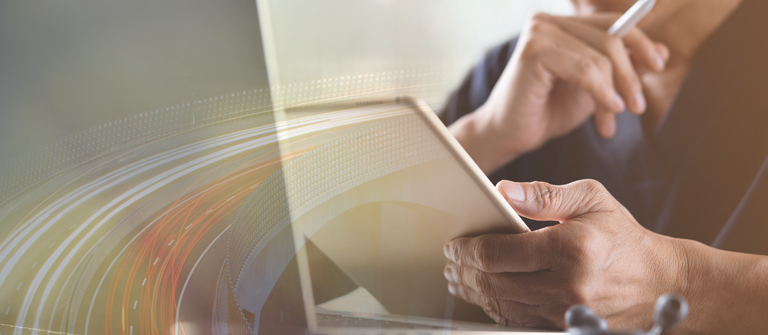In our podcast about cash flow, Rectangle Health’s Vice President of Enterprise Sales, Brian Doyle, describes how software like our Practice Management Bridge® increases collection rates and decreases days in accounts receivables. He also examines how this technology improves efficiency for practices and what staff can do with the time they get back.
Transcript
Michael Berman 00:00
Hello and welcome. I’m Michael Berman, and I’m here today with Brian Doyle, vice President of Enterprise Sales at Rectangle Health, to discuss how software solutions like our Practice Management Bridge impact cash flow for healthcare practices in larger organizations. The way we think about cash flow is the capture of patient payments so that it creates transference. It’s moving finances in so people can pay for expenses like personal protective equipment, rising inflation and wage increases. It’s trimming a day in accounts receivable to help people make payroll. In other words, it’s all about ease and efficiency. So let’s dive right into the questions. The first question when companies take a step toward unifying payment options and adopting user friendly payment and engagement technology, they’ve reported to have seen a fast return on investment.
So, Brian, in light of many healthcare organizations robust investments in software like our practice management bridge, can you comment on how these software solutions affect their cash flow?
How Practice Management Software Affects Cash Flow
Brian Doyle 01:05
Michael absolutely. The immediate return by implementing contactless solutions is increased collection rates. That’s the first thing that a provider will see. The second contactless software is put into place. We have seen consistently an increase in how patients are paying, and that’s digitally. When we think about that, we think about things like Amazon and Netflix. So by a healthcare provider offering those functions, the consumer is more comfortable and feels more at ease in making those payments. Something as simple as Apple pay. A consumer or a modern patient will make a payment faster. So first and foremost is increased collection rate. The second thing we see is reduced days in AR. So the consumers, the market, are dictating things like Card on File, Text-to-Pay, & digital e-statements.
The days of paper statement send out a bill, let’s hope they cut a check and send it back are dwindling. And that’s a really good thing for not only the provider, but for the patient experience as well. So things like QR codes are back transparently. I never used a QR code until COVID happened, and now they’re everywhere. And that’s the same concept in today’s healthcare environment. We want to put a QR code on our paper statement. We want a QR code in our operators or exam rooms. We want to make it as easy and convenient for a patient’s day as possible. And then lastly, what we’re seeing is by implementing automation or technology inside the provider’s offices, the providers are now allowed to allocate FTE hours to what they really should be doing, and that’s taking care of the patient anyway.
So when you combine those three aspects, and that is increased collection rates at the time of treatment, reduced days in AR, or quicker access to cash, and then reduced FTE hours and efficiencies. That all equates to better cash flow for the provider, quicker access to cash, more growth potential, lower days than they are. And that’s what digital technology is doing in today’s healthcare environment.
Increased Efficiency Leads to More Time
Michael Berman 03:20
Great. Thank you for that, Brian. I think the next question will be we’ve heard from a lot of our consumers that we believe are early adopters of technology about their enthusiasm. And when we survey them, they tell us how pleased they are with technology like our Practice Management Bridge and how they wish they would have adopted it sooner. What do you hear, Brian, from people after they adopt Practice Management Bridge? What are the effects?
Brian Doyle 03:49
Yeah, great question. The immediate feedback we get is improved efficiencies. That is the number one thing we hear the minute Bridge is implemented within the market. This is long term. The technology we’re using in our retail experience has been around in our day to day life for years. They’re not going away. We are going to pay in these modern technologies and what Bridge offers from now until something drastic changes which we don’t foresee happening anytime soon. So not only is technology increasing the efficiency within the provider’s office, which is very important, it’s improving the patient experience. And the patient experience is directly correlated to the amount of revenue a provider’s office will generate. So that’s the immediate return that we’re hearing once Bridge is implemented. And that’s efficiency.
Michael Berman 04:47
Great, thanks. And with efficiency, I’m assuming that this leads to practice administrators, office managers and providers getting more time back. And I’m wondering, what do you think these practices do with more time?
Brian Doyle 05:07
A provider gets into business to provide health care. They do not get in business to send out bills or try to collect money. That is not what they went to school for, it’s not what they’re trained for, and it’s not what they got into the business for in the first place. So the biggest value to a provider and then therefore their staff, by implementing contactless digital new Age technology is allocating those Ftes to what they’re there for. And that’s patient care and patient health care, that is the most immediate and impactful piece of this software that we can put in the market. So they’re taking Ftes and putting them more toward the patient, making them patient centric, making the healthcare the priority. Again, not spending time calling, taking calls, fielding calls and billing.
Michael Berman 05:59
Great. Thank you so much. This has been so incredibly useful. Thank you very much for joining us today, Brian. And yeah, to all of you listeners, please be sure to visit our website for more information about Rectangle Health technology. You thanks so much.



